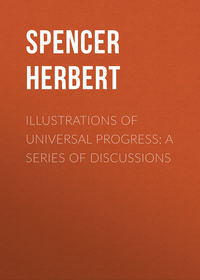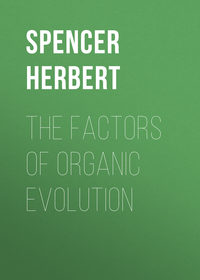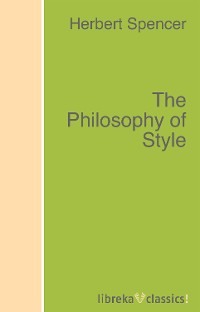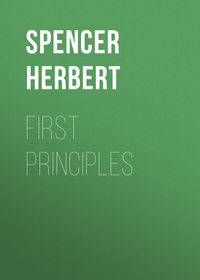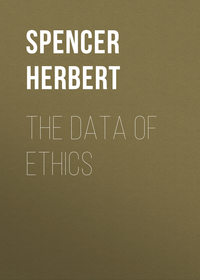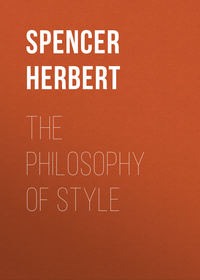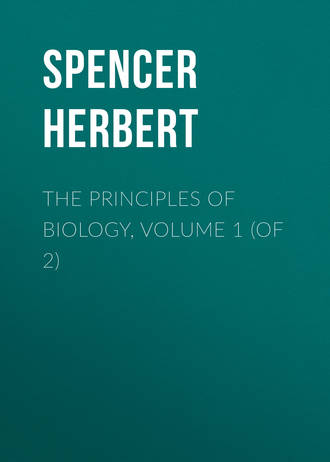 полная версия
полная версияThe Principles of Biology, Volume 1 (of 2)
So far, then, am I from feeling that Professor Weismann has here raised a difficulty in the way of the doctrine I hold, that I feel indebted to him for having drawn attention to a very strong evidence in its support. This modification in the form of the foot, which has occurred since arboreal habits have given place to terrestrial habits, shows the effects of use and disuse simultaneously. The inner digits have increased by use while the outer digits have decreased by disuse.
* * * * *Saying that he will not "pause to refute other apparent proofs of the transmission of acquired characters," Professor Weismann proceeds to deal with the argument which, with various illustrations, I have several times urged – the argument that the natural selection of fortuitously-arising variations cannot account for the adjustment of co-operative parts. Very clearly and very fairly he summarises this argument as used in The Principles of Biology in 1864. Admitting that in this case there are "enormous difficulties" in the way of any other interpretation than the inheritance of acquired characters, Professor Weismann before proceeding to assault this "last bulwark of the Lamarckian principle," premises that the inheritance of acquired characters cannot be a cause of change because inactive as well as active parts degenerate when they cease to be of use: instancing the "skin and skin-armature of crabs and insects." On this I may remark in the first place that an argument derived from degeneracy of passive structures scarcely meets the case of development of active structures; and I may remark in the second place that I have never dreamt of denying the efficiency of natural selection as a cause of degeneracy in passive structures when the degeneracy is such as aids the prosperity of the stirp.
Making this parenthetical reply to his parenthetical criticism I pass to his discussion of this particular argument which he undertakes to dispose of.
His cheval de bataille is furnished him by the social insects – not a fresh one, however, as might be supposed from the way in which he mounts it. From time to time it has carried other riders, who have couched their lances with fatal effects as they supposed. But I hope to show that no one of them has unhorsed an antagonist, and that Professor Weismann fails to do this just as completely as his predecessors. I am, indeed, not sorry that he has afforded me the opportunity of criticising the general discussion concerning the peculiarities of these interesting creatures, which it has often seemed to me sets out with illegitimate assumptions. The supposition always is that the specialities of structures and instincts in the unlike classes of their communities, have arisen during the period in which the communities have existed in something like their present forms. This cannot be. It is doubtless true that association without differentiations of classes may pre-exist for co-operative purposes, as among wolves, and as among various insects which swarm under certain circumstances. Hence we may suppose that there arise in some cases permanent swarms – that survival of the fittest will establish these constant swarms where they are advantageous. But admitting this, we have also to admit a gradual rise of the associated state out of the solitary state. Wasps and bees present us with gradations. If, then, we are to understand how the organized societies have arisen, either out of the solitary state or out of undifferentiated swarms, we must assume that the differences of structure and instinct among the members of them arose little by little, as the social organization arose little by little. Fortunately we are able to trace the greater part of the process in the annually-formed communities of the common wasp; and we shall recognize in it an all-important factor (ignored by Professor Weismann) to which the phenomena, or at any rate the greater part of them, are due.
But before describing the wasp's annual history, let me set down certain observations made when, as a boy, I was given to angling, and, in July or August, sometimes used for bait "wasp-grubs," as they were called. After having had two or three days the combs or "cakes" of these, full of unfed larvæ in all stages of growth, I often saw some of them devouring the edges of their cells to satisfy their appetites; and saw others, probably the most advanced in growth, which were spinning the little covering caps to their cells, in preparation for assuming the pupa state. It is to be inferred that if, after a certain stage of growth has been reached, the food-supply becomes inadequate or is stopped altogether, the larva undergoes its transformation prematurely; and, as we shall presently see, this premature transformation has several natural sequences.
Let us return now to the wasp's family history. In the spring, a queen-wasp or mother-wasp which has survived the winter, begins to make a small nest containing four or more cells in which she lays eggs, and as fast as she builds additional cells, she lays an egg in each. Presently, to these activities, is added the feeding of the larvæ: one result being that the multiplication of larvæ involves a restriction of the food that can be given to each. If we suppose that the mother-wasp rears no more larvæ than she can fully feed, there will result queens or mothers like herself, relatively few in number. But if we suppose that, laying more numerous eggs she produces more larvæ than she can fully feed, the result will be that when these have reached a certain stage of growth, inadequate supply of food will be followed by premature retirement and transformation into pupæ. What will be the characters of the developed insects? The first effect of arrested nutrition will be smaller size. This we find. A second effect will be defective development of parts that are latest formed and least important for the survival of the individual. Hence we may look for arrested development of the reproductive organs – non-essential to individual life. And this expectation is in accord with what we see in animal development at large; for (passing over entirely sexless individuals) we see that though the reproductive organs may be marked out early in the course of development, they are not made fit for action until after the structures for carrying on individual life are nearly complete. The implication is, then, that an inadequately-fed and small larva will become a sterile imago. Having noted this, let us pass to a remarkable concomitant. In the course of development, organs are formed not alone in the order of their original succession, but partly in the order of importance and the share they have to take in adult activities – a change of order called by Haeckel "heterochrony." Hence the fact that we often see the maternal instinct precede the sexual instinct. Every little girl with her doll shows us that the one may become alive while the other remains dormant. In the case of wasps, then, premature arrest of development may result in incompleteness of the sexual traits, along with completeness of the maternal traits. What happens? Leave out the laying of eggs, and the energies of the mother-wasp are spent wholly in building cells and feeding larvæ, and the worker-wasp forthwith begins to spend its life in building cells and feeding larvæ. Thus interpreting the facts, we have no occasion to assume any constitutional difference between the eggs of worker-wasps and the eggs of queens; and that, their eggs are not different we see, first, in the fact that occasionally the worker-wasp is fertile and lays drone-producing eggs, and we see secondly that (if in this respect they are like the bees, of which, however, we have no proof) the larva of a worker-wasp can be changed into the larva of a queen-wasp by special feeding. But be this as it may, we have good evidence that the feeding determines everything. Says Dr. Ormerod, in his British Social Wasps: —
"When the swarm is strong and food plentiful … the well fed larvæ develop into females, full, large, and overflowing with fat. There are all gradations of size, from the large fat female to the smallest worker… The larger the wasp, the larger and better developed, as the rule, are the female organs, in all their details. In the largest wasps, which are to be the queens of another year, the ovaries differ to all appearances in nothing but their size from those of the larger worker wasps… Small feeble swarms produce few or no perfect females; but in large strong swarms they are found by the score." (pp. 248-9)
To this evidence add the further evidence that queens and workers pass through certain parallel stages in respect of their maternal activities. At first the queen, besides laying eggs, builds cells and feeds larvæ, but after a time ceases to build cells, and feeds larvæ only, and eventually doing neither one nor the other, only lays eggs, and is supplied with food by the workers. So it is in part with the workers. While the members of each successive brood, when in full vigour, build cells and feed larvæ, by-and-by they cease to build cells, and only feed larvæ: the maternal activities and instincts undergo analogous changes. In this case, then, we are not obliged to assume that only by a process of natural selection can the differences of structure and instinct between queens and workers be produced. The only way in which natural selection here comes into play is in the better survival of the families of those queens which made as many cells, and laid as many eggs, as resulted in the best number of half-fed larvæ, producing workers; since by a rapid multiplication of workers the family is advantaged, and the ultimate production of more queens surviving into the next year insured.
The differentiation of classes does not go far among the wasps, because the cycle of processes is limited to a year, or rather to the few months of the summer. It goes further among the hive-bees, which, by storing food, survive from one year into the next. Unlike the queen-wasp, the queen-bee neither builds cells nor gathers food, but is fed by the workers: egg laying has become her sole business. On the other hand the workers, occupied exclusively in building and nursing, have the reproductive organs more dwarfed than they are in wasps. Still we see that the worker-bee occasionally lays drone-producing eggs, and that, by giving extra nutriment and the required extra space, a worker-larva can be developed into a queen-larva. In respect to the leading traits, therefore, the same interpretation holds. Doubtless there are subsidiary instincts which are apparently not thus interpretable. But before it can be assumed that an interpretation of another kind is necessary, it must be shown that these instincts cannot be traced back to those pre-social types and semi-social types which must have preceded the social types we now see. For unquestionably existing bees must have brought with them from the pre-social state an extensive endowment of instincts, and, acquiring other instincts during the unorganized social state, must have brought these into the present organized social state. It is clear, for instance, that the cell-building instinct in all its elaboration was mainly developed in the pre-social stage; for the transition from species building solitary cells to those building combs is traceable. We are similarly enabled to account for swarming as being an inheritance from remote ancestral types. For just in the same way that, with under-feeding of larvæ, there result individuals with imperfectly developed reproductive systems, so there will result individuals with imperfect sexual instincts; and just as the imperfect reproductive system partially operates upon occasion, so will the imperfect sexual instinct. Whence it will result that on the event which causes a queen to undertake a nuptial flight which is effectual, the workers may take abortive nuptial flights: so causing a swarm.
And here, before going further, let us note an instructive class of facts related to the class of facts above set forth. Summing up, in a chapter on "The Determination of Sex," an induction from many cases, Professor Geddes and Mr. Thompson remark that "such conditions as deficient or abnormal food," and others causing "preponderance of waste over repair … tend to result in production of males;" while "abundant and rich nutrition" and other conditions which "favour constructive processes … result in the production of females."118 Among such evidences of this as immediately concern us, are these: – J. H. Fabre found that in the nests of Osmia tricornis, eggs at the bottom, first laid, and accompanied by much food, produced females, while those at the top, last laid, and accompanied by one-half or one-third the quantity of food, produced males,119 Huber's observations on egg-laying by the honey-bee, show that in the normal course of things, the queen lays eggs of workers for eleven months, and only then lays eggs of drones: that is, when declining nutrition or exhaustion has set in. Further, we have the above-named fact, shown by wasps and bees, that when workers lay eggs these produce drones only.120 Special evidence, harmonizing with general evidence, thus proves that among the social insects the sex is determined by degree of nutrition while the egg is being formed. See then how congruous this evidence is with the conclusion above drawn; for it is proved that after an egg, predetermined as a female, has been laid, the character of the produced insect as a perfect female or imperfect female is determined by the nutrition of the larva. That is, one set of differences in structures and instincts is determined by nutrition before the egg is laid, and a further set of differences in structures and instincts is determined by nutrition after the egg is laid.
We come now to the extreme case – that of the ants. Is it not probable that the process of differentiation has been similar? There are sundry reasons for thinking so. With ants as with wasps and bees – the workers occasionally lay eggs; and an ant-community can, like a bee-community, when need be, produce queens out of worker-larvæ: presumably in the same manner by extra feeding. But here we have to add special evidence of great significance. For observe that the very facts concerning ants, which Professor Weismann names as exemplifying the formation of the worker type by selection, serve, as in the case of wasps, to exemplify its formation by arrested nutrition. He says that in several species the egg-tubes in the ovaries show progressive decrease in number; and this, like the different degrees of arrest in the ovaries of the worker-wasps, indicates arrest of larva-feeding at different stages. He gives cases showing that, in different degrees, the eyes of workers are less developed in the number of their facets than those of the perfect insects; and he also refers to the wings of workers as not being developed: remarking, however, that the rudiments of their wings show that the ancestral forms had wings. Are not these traits also results of arrested nutrition? Generally among insects the larvæ are either blind or have but rudimentary eyes; that is to say, visual organs are among the latest organs to arise in the genesis of the perfect organism. Hence early arrest of nutrition will stop formation of these, while various more ancient structures have become tolerably complete. Similarly with wings. Wings are late organs in insect phylogeny, and therefore will be among those most likely to abort where development is prematurely arrested. And both these traits will, for the same reason, naturally go along with arrested development of the reproductive system. Even more significant, however, is some evidence assigned by Mr. Darwin respecting the caste-gradations among the driver ants of West Africa. He says: —
"But the most important fact for us is, that, though the workers can be grouped into castes of different sizes, yet they graduate insensibly into each other, as does the widely-different structure of their jaws."121
"Graduate insensibly," he says; implying that there are very numerous intermediate forms. This is exactly what is to be expected if arrest of nutrition be the cause; for unless the ants have definite measures, enabling them to stop feeding at just the same stages, it must happen that the stoppage of feeding will be indefinite; and that, therefore, there will be all gradations between the extreme forms – "insensible gradations," both in size and in jaw-structure.
In contrast with this interpretation, consider now that of Professor Weismann. From whichever of the two possible suppositions he sets out, the result is equally fatal. If he is consistent, he must say that each of these intermediate forms of workers must have its special set of "determinants," causing its special set of modifications of organs; for he cannot assume that while perfect females and the extreme types of workers have their different sets of determinants, the intermediate types of workers have not. Hence we are introduced to the strange conclusion that besides the markedly-distinguished sets of determinants there must be, to produce these intermediate forms, many other sets slightly distinguished from one another – a score or more kinds of germ-plasm in addition to the four chief kinds. Next comes an introduction to the still stranger conclusion, that these numerous kinds of germ-plasm, producing these numerous intermediate forms, are not simply needless but injurious – produce forms not well fitted for either of the functions discharged by the extreme forms: the implication being that natural selection has originated these disadvantageous forms! If to escape from this necessity for suicide, Professor Weismann accepts the inference that the differences among these numerous intermediate forms are caused by arrested feeding of the larvæ at different stages, then he is bound to admit that the differences between the extreme forms, and between these and perfect females, are similarly caused. But if he does this, what becomes of his hypothesis that the several castes are constitutionally distinct, and result from the operation of natural selection? Observe, too, that his theory does not even allow him to make this choice; for we have clear proof that unlikenesses among the forms of the same species cannot be determined this way or that way by differences of nutrition. English greyhounds and Scotch greyhounds do not differ from one another so much as do the Amazon-workers from the inferior workers, or the workers from the queens. But no matter how a pregnant Scotch greyhound is fed, or her pups after they are born, they cannot be changed into English greyhounds: the different germ-plasms assert themselves spite of all treatment. But in these social insects the different structures of queens and workers are determinable by differences of feeling. Therefore the production of their various castes does not result from the natural selection of varying germ-plasm.
Before dealing with Professor Weismann's crucial case – that co-adaptation of parts, which, in the soldier-ants, has, he thinks, arisen without inheritance of acquired characters – let me deal with an ancillary case which he puts forward as explicable by "panmixia alone." This is the "degeneration, in the warlike Amazon-ants, of the instinct to search for food."122 Let us first ask what have been the probable antecedents of these Amazon-ants; for, as I have above said, it is absurd to speculate about the structures and instincts the species possesses in its existing organized social state without asking what structures and instincts it brought with it from its original solitary state and its unorganized social state. From the outset these ants were predatory. Some variety of them led to swarm – probably at the sexual season – did not again disperse so soon as other varieties. Those which thus kept together derived advantages from making simultaneous attacks on prey, and prospered accordingly. Of descendants the varieties which carried on longest the associated state prospered most; until, at length, the associated state became permanent. All which social progress took place while there existed only perfect males and females. What was the next step? Ants utilize other insects, and, among other ways of doing this, sometimes make their nests where there are useful insects ready to be utilized. Giving an account of certain New Zealand species of Tetramorium, Mr. W. W. Smith says they seek out underground places where there are "root-feeding aphides and coccids," which they begin to treat as domestic animals; and further he says that when, after the pairing season, new nests are being formed, there are "a few ants of both sexes … from two up to eight or ten."123 Carrying with us this fact as a key, let us ask what habits will be fallen into by the conquering species of ants. They, too, will seek places where there are creatures to be utilized; and, finding it profitable, will invade the habitations not of defenceless creatures only, but of creatures whose powers of defence are inadequate – weaker species of their own order. A very small modification will affiliate their habits on habits of their prototypes. Instead of being supplied with sweet substance excreted by the aphides they are supplied with sweet substance by the ants among which they parasitically settle themselves. How easily the subjugated ants may fall into the habit of feeding them, we shall see on remembering that already they feed not only larvæ but adults – individuals bigger than themselves. And that attentions kindred to these paid to parasitic ants may be established without difficulty, is shown us by the small birds which continue to feed a young cuckoo in their nest when it has outgrown them. This advanced form of parasitism grew up while there were yet only perfect males and females, as happens in the initial stage with these New Zealand ants. What further modifications of habits were probably then acquired? From the practice of settling themselves where there already exist colonies of aphides, which they carry about to suitable places in the nest, like Tetramorium, other ants pass to the practice of making excursions to get aphides, and putting them in better feeding places where they become more productive of saccharine matter. By a parallel step these soldier-ants pass from the stage of settling themselves among other ants which feed them, to the stage of fetching the pupæ of such ants to the nest: a transition like that which occurs among slave-making human beings. Thus by processes analogous to those we see going on, these communities of slave-making ants may be formed. And since the transition from an unorganized social state to a social state characterized by castes, must have been gradual, there must have been a long interval during which the perfect males and females of these conquering ants could acquire habits and transmit them to progeny. A small modification accounts for that seemingly-strange habit which Professor Weismann signalizes. For if, as is observed, those ants which keep aphides solicit them to excrete a supply of ant-food by stroking them with the antennæ, they come very near to doing that which Professor Weismann says the soldier-ants do towards a worker – "they come to it and beg for food: " the food being put into their mouths in this last case as almost or quite in the first. And evidently this habit of passively receiving food, continued through many generations of perfect males and females, may result in such disuse of the power of self-feeding that this is eventually lost. The behaviour of young birds, during, and after, their nest-life, gives us the clue. For a week or more after they are full-grown and fly about with their parents, they may be seen begging for food and making no efforts to recognize and pick up food for themselves. If, generation after generation, feeding of them in full measure continued, they would not learn to feed themselves: the perceptions and instincts implied in self-feeding would be later and later developed, until, with entire disuse of them, they would disappear altogether by inheritance. Thus self-feeding may readily have ceased among these soldier-ants before the caste-organization arose among them.
With this interpretation compare the interpretation of Professor Weismann. I have before protested against arguing in abstracts without descending to concretes. Here let us ask what are the particular changes which the alleged explanation by survival of the fittest involves. Suppose we make the very liberal supposition that an ant's central ganglion bears to its body the same ratio as the human brain bears to the human body – say, one-fortieth of its weight. Assuming this, what shall we assume to be the weight of those ganglion-cells and fibres in which are localized the perceptions of food and the suggestion to take it? Shall we say that these amount to one-tenth of the central ganglion? This is a high estimate considering all the impressions which this ganglion has to receive, and all the operations which it has to direct. Still we will say one-tenth. Then it follows that this portion of nervous substance is one-400th of the weight of its body. By what series of variations shall we say that it is reduced from full power to entire incapacity? Shall we say five? This is a small number to assume. Nevertheless we will assume it. What results? That the economy of nerve-substance achieved by each of these five variations will amount to one-2000th of the entire mass. Making these highly favourable assumptions, what follows: – The queen-ant lays eggs that give origin to individuals in each of which there is achieved an economy in nerve-substance of one-2000th of its weight; and the implication of the hypothesis is that such an economy will so advantage this ant-community that in the competition with other ant-communities it will conquer. For here let me recall the truth before insisted upon, that natural selection can operate only on those variations which appreciably benefit the stirp. Bearing in mind this requirement, is any one now prepared to say that survival of the fittest can cause this decline of the self-feeding faculty?124



